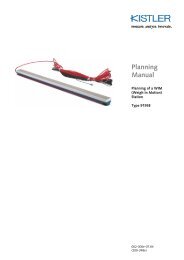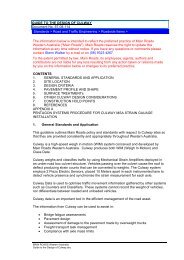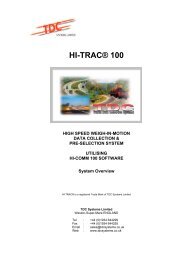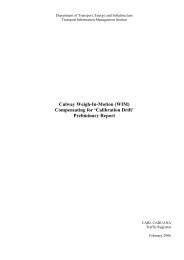AP-G84/04 Best practice in road use data collection, analysis ... - WIM
AP-G84/04 Best practice in road use data collection, analysis ... - WIM
AP-G84/04 Best practice in road use data collection, analysis ... - WIM
Create successful ePaper yourself
Turn your PDF publications into a flip-book with our unique Google optimized e-Paper software.
Accessed by AR - ARRB TRANSPORT RESEARCH on <strong>04</strong> Feb 2005<br />
Aust<strong>road</strong>s 20<strong>04</strong><br />
— 54 —<br />
<strong>Best</strong> Practices <strong>in</strong> Road Use Data Collection, Analysis and Report<strong>in</strong>g<br />
9. Miss<strong>in</strong>g <strong>data</strong> – it is good <strong>practice</strong> to edit and provide miss<strong>in</strong>g <strong>data</strong>. For estimat<strong>in</strong>g miss<strong>in</strong>g<br />
<strong>data</strong>, it is necessary to refer to historical and current <strong>in</strong>formation from previous and<br />
subsequent weeks and available <strong>data</strong> for the pattern relat<strong>in</strong>g to weekdays flows. The<br />
management of miss<strong>in</strong>g <strong>data</strong> still requires substantially more research. A vital po<strong>in</strong>t is to flag<br />
amended <strong>data</strong> and ensure that the orig<strong>in</strong>al raw <strong>data</strong> sets can be recovered should better<br />
estimation techniques become available.<br />
10. Short duration counts - Counts of very short durations of a few hours or even 12 hours are<br />
not reliable for traffic forecast<strong>in</strong>g. With automatic count<strong>in</strong>g equipment now commonly<br />
deployed, the extra cost of collect<strong>in</strong>g <strong>data</strong> on more days should be m<strong>in</strong>imal. The best way to<br />
ensure consistency amongst RAs is for each RA to collect robust <strong>data</strong> sets, i.e. collect<strong>in</strong>g<br />
<strong>data</strong> over a consecutive period of, say, seven days at Short-term Stations.<br />
11. Weigh-<strong>in</strong>-motion <strong>data</strong> - <strong>WIM</strong> site selection and equipment calibration ensure <strong>data</strong> accuracy<br />
and are requirements of good <strong>practice</strong>. The potential impact of weather conditions on some<br />
pavement surfaces should be noted. As long as all lanes of traffic are monitored at a <strong>WIM</strong><br />
site, the traffic count and <strong>WIM</strong> <strong>data</strong> should add extra value to a count<strong>in</strong>g program.<br />
12. Stakeholder consultation - good <strong>practice</strong> is achieved by adopt<strong>in</strong>g a corporate <strong>road</strong> <strong>use</strong> <strong>data</strong><br />
<strong>collection</strong> framework and engag<strong>in</strong>g stakeholders. Many activities require <strong>road</strong> <strong>use</strong> <strong>data</strong> and a<br />
diverse group of stakeholders are <strong>in</strong>volved. As such, <strong>road</strong> <strong>use</strong> <strong>data</strong> is a corporate asset that<br />
requires its share of corporate plann<strong>in</strong>g and management.<br />
13. Future research - the follow<strong>in</strong>g areas are identified:<br />
− Determ<strong>in</strong>e the threshold values for automatic vehicle classification system by lengths;<br />
− Develop a model for the correlation of <strong>WIM</strong> <strong>data</strong> with classified counts; and<br />
− Develop a policy or bus<strong>in</strong>ess model on <strong>data</strong> <strong>in</strong>tegration, accessibility and pric<strong>in</strong>g.

















